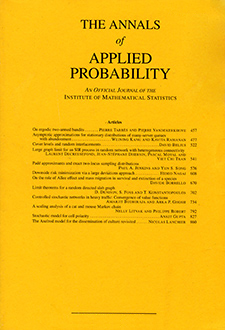Abstract
Brownian networks are a class of linear stochastic control systems that arise as heavy traffic approximations in queueing theory. Such Brownian system models have been used to approximate problems of dynamic routing, dynamic sequencing and dynamic input control for queueing networks. A number of specific examples have been analyzed in recent years, and in each case the Brownian network has been successfully reduced to an "equivalent workload formulation" of lower dimension. In this article we explain that reduction in general terms, using an orthogonal decomposition that distinguishes between reversible and irreversible controls.
Citation
J. Michael Harrison. Jan A. Van Mieghem. "Dynamic control of Brownian networks: state space collapse and equivalent workload formulations." Ann. Appl. Probab. 7 (3) 747 - 771, August 1997. https://doi.org/10.1214/aoap/1034801252
Information





